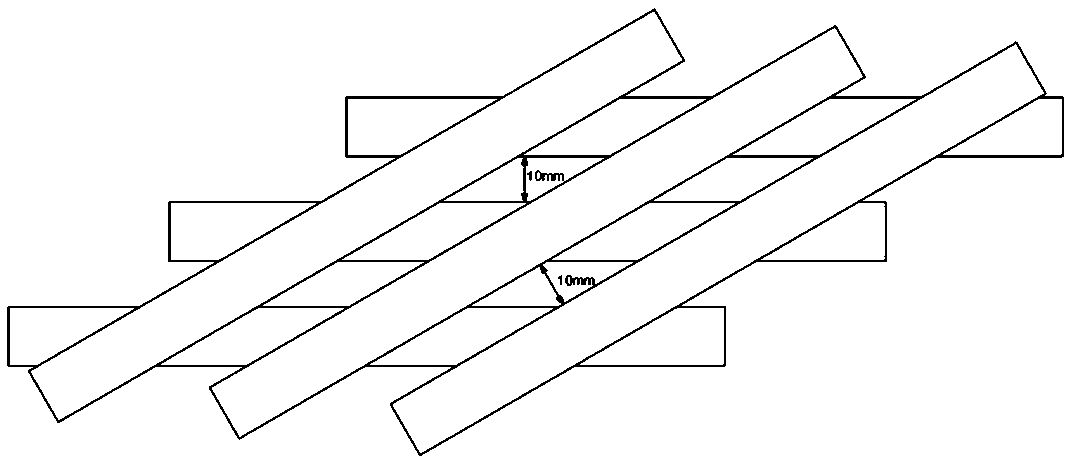Antibacterial spunlace non-woven fabric and preparation method thereof
A technology of spunlace non-woven fabrics and non-woven fabrics, applied in the directions of non-woven fabrics, rayon manufacturing, textiles and papermaking, etc., can solve problems such as practical applications that are difficult to meet high requirements, and achieve uniform and good filtration effect and air permeability The effect of high stability, good molding quality and high production efficiency
- Summary
- Abstract
- Description
- Claims
- Application Information
AI Technical Summary
Problems solved by technology
Method used
Image
Examples
Embodiment 1
[0037] A kind of preparation method of antibacterial spunlace nonwoven fabric, comprises following preparation steps:
[0038] First, prepare antibacterial non-woven monomer fibers:
[0039] a) Take alkali-resistant glass fiber as raw material, mix it with molten polyurethane and antibacterial agent under the action of slitting and shearing, and fully stir to form the surface layer of non-woven monomer fiber; among them, the alkali-resistant glass fiber, polyurethane and antibacterial agent The mixing mass ratio is 1:2:1;
[0040] b) Take nano-scale tea fiber as the core material;
[0041] c) Extrude the core material through the round hole of the extruder die, and extrude the surface layer of the non-woven monomer fiber through the outer ring of the extruder die to obtain the antibacterial non-woven monomer fiber wrapped with the core material.
[0042] Then, antibacterial spunlace nonwovens were prepared based on antibacterial nonwoven monomer fibers.
[0043] S1. Opening...
Embodiment 2
[0052] First, prepare antibacterial non-woven monomer fibers:
[0053] a) Take alkali-resistant glass fiber as raw material, mix it with molten polyurethane and antibacterial agent under the action of slitting and shearing, and fully stir to form the surface layer of non-woven monomer fiber; among them, the alkali-resistant glass fiber, polyurethane and antibacterial agent The mixing mass ratio is 1:4:1;
[0054] b) Take nano-scale tea fiber as the core material;
[0055] c) Extrude the core material through the round hole of the extruder die, and extrude the surface layer of the non-woven monomer fiber through the outer ring of the extruder die to obtain the antibacterial non-woven monomer fiber wrapped with the core material.
[0056] Then, antibacterial spunlace nonwovens were prepared based on antibacterial nonwoven monomer fibers.
[0057] S1. Opening: The antibacterial non-woven fabric monomer fibers are washed 5 times with sterile water, and then immersed in 52° C. wa...
Embodiment 3
[0066] First, prepare antibacterial non-woven monomer fibers:
[0067] a) Take alkali-resistant glass fiber as raw material, mix it with molten polyurethane and antibacterial agent under the action of slitting and shearing, and fully stir to form the surface layer of non-woven monomer fiber; among them, the alkali-resistant glass fiber, polyurethane and antibacterial agent The mixing mass ratio is 1:5:1;
[0068] b) Take nano-scale tea fiber as the core material;
[0069] c) Extrude the core material through the round hole of the extruder die, and extrude the surface layer of the non-woven monomer fiber through the outer ring of the extruder die to obtain the antibacterial non-woven monomer fiber wrapped with the core material.
[0070] Then, antibacterial spunlace nonwovens were prepared based on antibacterial nonwoven monomer fibers.
[0071] S1. Opening: The antibacterial non-woven fabric monomer fibers are washed 4 times with sterile water, and then immersed in 50° C. wa...
PUM
| Property | Measurement | Unit |
|---|---|---|
| thickness | aaaaa | aaaaa |
Abstract
Description
Claims
Application Information
 Login to View More
Login to View More - Generate Ideas
- Intellectual Property
- Life Sciences
- Materials
- Tech Scout
- Unparalleled Data Quality
- Higher Quality Content
- 60% Fewer Hallucinations
Browse by: Latest US Patents, China's latest patents, Technical Efficacy Thesaurus, Application Domain, Technology Topic, Popular Technical Reports.
© 2025 PatSnap. All rights reserved.Legal|Privacy policy|Modern Slavery Act Transparency Statement|Sitemap|About US| Contact US: help@patsnap.com



